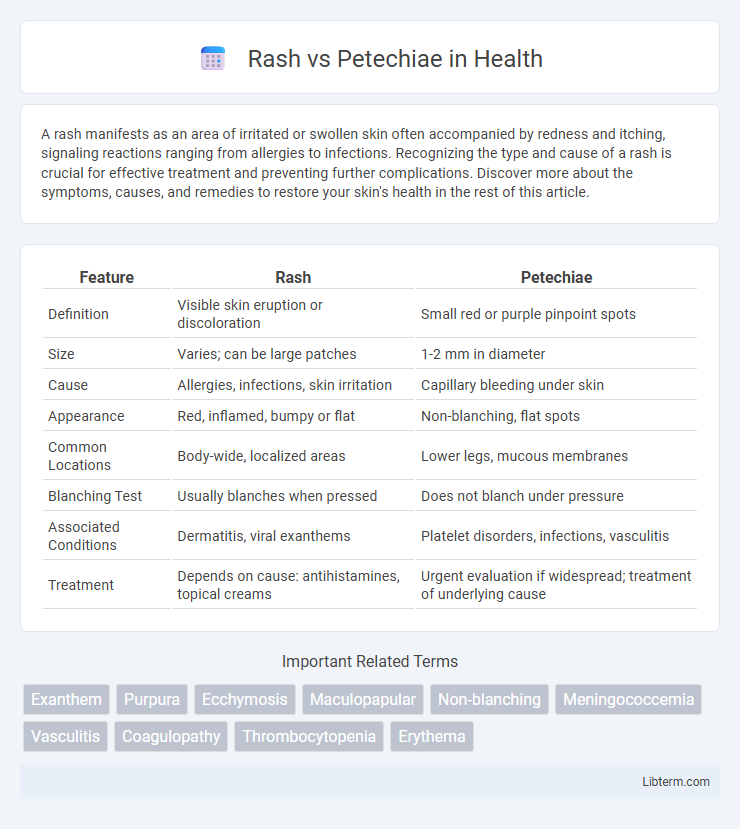A rash manifests as an area of irritated or swollen skin often accompanied by redness and itching, signaling reactions ranging from allergies to infections. Recognizing the type and cause of a rash is crucial for effective treatment and preventing further complications. Discover more about the symptoms, causes, and remedies to restore your skin's health in the rest of this article.
Table of Comparison
| Feature | Rash | Petechiae |
|---|---|---|
| Definition | Visible skin eruption or discoloration | Small red or purple pinpoint spots |
| Size | Varies; can be large patches | 1-2 mm in diameter |
| Cause | Allergies, infections, skin irritation | Capillary bleeding under skin |
| Appearance | Red, inflamed, bumpy or flat | Non-blanching, flat spots |
| Common Locations | Body-wide, localized areas | Lower legs, mucous membranes |
| Blanching Test | Usually blanches when pressed | Does not blanch under pressure |
| Associated Conditions | Dermatitis, viral exanthems | Platelet disorders, infections, vasculitis |
| Treatment | Depends on cause: antihistamines, topical creams | Urgent evaluation if widespread; treatment of underlying cause |
Understanding Rash and Petechiae: Key Differences
Rash and petechiae are distinct skin conditions characterized by different appearances and causes. A rash typically presents as a widespread area of inflamed, red, or irritated skin, often caused by allergic reactions, infections, or other underlying health issues. Petechiae are small, pinpoint red or purple spots resulting from minor bleeding under the skin, commonly linked to conditions affecting blood clotting or vascular integrity.
Common Causes of Rashes
Common causes of rashes include allergic reactions, infections, autoimmune diseases, and irritants such as chemicals or heat. Rashes often present as red, inflamed skin with itching or swelling, contrasting with petechiae which are tiny, pinpoint hemorrhages caused by capillary bleeding. Viral infections like measles and bacterial infections such as scarlet fever frequently lead to widespread rashes.
Common Causes of Petechiae
Petechiae are tiny, pinpoint red or purple spots caused by bleeding under the skin, often resulting from platelet abnormalities, infections like meningococcemia, or physical trauma such as intense coughing or straining. Unlike generalized rashes, petechiae do not blanch when pressed and commonly indicate underlying conditions like thrombocytopenia, vasculitis, or certain medications affecting clotting. Recognizing these common causes of petechiae is crucial for early diagnosis and effective treatment of potentially serious health issues.
Recognizing Symptoms: Rash vs Petechiae
Rash and petechiae both present as skin abnormalities but differ in appearance and underlying causes. A rash typically appears as red, inflamed, or bumpy patches caused by allergic reactions, infections, or chronic conditions, while petechiae are small, pinpoint red or purple spots resulting from bleeding under the skin due to platelet disorders or vascular issues. Recognizing symptoms involves noting that petechiae do not blanch when pressed, whereas many rashes may fade temporarily under pressure.
When to Worry: Warning Signs and Red Flags
Rash accompanied by symptoms such as sudden onset, widespread distribution, purpura, or fever may indicate a serious infection or allergic reaction requiring immediate medical evaluation. Petechiae, characterized by tiny, pinpoint red or purple spots caused by bleeding under the skin, can signal underlying conditions like thrombocytopenia or vasculitis, especially when they do not fade under pressure or are widespread. Persistent petechiae with easy bruising, mucous membrane bleeding, or systemic symptoms such as fatigue and weight loss necessitate urgent medical attention to rule out hematologic disorders or infectious diseases.
Diagnostic Approaches for Rash and Petechiae
Diagnostic approaches for rash involve assessing morphology, distribution, and associated symptoms, often supported by skin biopsy and laboratory tests to identify infections or autoimmune conditions. Petechiae diagnosis requires careful clinical examination to distinguish from similar lesions, with complete blood count and coagulation studies essential to evaluate platelet count and clotting function. Differentiating petechiae from other rashes is critical due to their association with underlying conditions such as thrombocytopenia or vasculitis, guiding urgent intervention.
Treatment Options: Rash vs Petechiae
Treatment options for rashes typically involve topical corticosteroids, antihistamines, or moisturizers, depending on the underlying cause such as eczema, allergic reactions, or infections. Petechiae require addressing the root cause, often involving blood disorders or infections, and may necessitate urgent medical evaluation for conditions like thrombocytopenia or vasculitis, with treatments including corticosteroids, platelet transfusions, or antibiotics. Accurate diagnosis through clinical examination and laboratory tests guides effective management for both skin manifestations.
Preventive Measures for Skin Health
Maintaining proper skin hygiene and moisturizing regularly can significantly reduce the risk of both rash and petechiae by preserving skin integrity and preventing irritation. Avoiding known allergens and irritants minimizes inflammatory skin reactions commonly associated with rashes, while managing underlying health conditions such as infections, platelet disorders, or vascular issues helps prevent petechiae. Wearing protective clothing and practicing gentle skin care routines support overall skin health and reduce susceptibility to these conditions.
When to Seek Medical Attention
Seek medical attention immediately if a rash is accompanied by high fever, difficulty breathing, or swelling, as these symptoms may indicate a serious infection or allergic reaction. Petechiae, which are small red or purple spots caused by bleeding under the skin, require urgent evaluation if they appear suddenly, spread rapidly, or are associated with symptoms such as bruising, fatigue, or unexplained bleeding. Prompt diagnosis by a healthcare professional is crucial to determine the underlying cause and initiate appropriate treatment.
Frequently Asked Questions: Rash vs Petechiae
Rash and petechiae are both skin conditions but differ significantly in appearance and causes; rashes typically present as inflamed, red patches or bumps, while petechiae appear as tiny, pinpoint, red or purple dots caused by bleeding under the skin. Frequently asked questions often center around identifying whether spots are petechiae or a rash, with petechiae not blanching under pressure, unlike many rashes. Understanding these differences helps in recognizing when to seek medical attention, as petechiae may indicate serious conditions such as infections or blood disorders.
Rash Infographic

 libterm.com
libterm.com